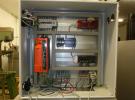Hi,
I am trying to measure the voltage on an anlogue output from an instrument at work. The output is between -0.7 and +0.7 V. I'm measuring this on a U12, as a differential voltage versus the instrument's ground on AI0 and AI1. I'm using the highest gain setting (20) as this will cover the range of the output. I'm running the labjack on a raspberry pi via labjackpython+exodriver. I went with a U12 as it seemed to be a better match for my signal than a U3-HV, as it supports negative voltages and has programmable gain whereas the U3-HV does not have the gain (as far as I could tell).
I'm finding the voltage measurement to be quite noisy, perhaps +/- 0.02 V between two successive measurements. Is this to be expected? If I measure the signal with a multimeter it is quite stable to 0.001 V.
Is there a way to improve my readings? If I average a few repeated measurements the noise gets better, but eventually I run into limitations with the speed of each measurement. I was hoping to use the burst mode, but I think the high level function is not supported on linux (please correct me if I'm wrong). I could perhaps use the low-level aiburst function, but I'm not exactly sure how to do this?
Any help would be appreciated,
Thanks,
James



.png%3Fitok=PHGBxf6M)


.jpg%3Fitok=B1YcuDFK)
.png%3Fitok=Ybt-OlgU)
The U6/T7 families would do much better, but for a low cost and low speed device you are correct that the U12 has an edge over the T4/U3 for your +/-0.7V signal.
The following suggests a typical noise level of +/-1 bits:
https://labjack.com/support/datasheets/u12/appendix-a
I don't recall if that is true for Gain=x20, but I suggest you test. Remove your signal, and instead jumper AI0 & AI1 both to GND and then observe the noise level.
If you are on the +/-1 volt range, the resolution is 2/4096 = 0.5 mV per bit. Confirm that you see this resolution level. If you just see readings bouncing by 10 mV, you know you are using the +/-20V range not the +/-1V range.
Note that a DMM is not good for seeing noise. It takes very slow readings, over 1 second perhaps, and noise gets hidden.
When you measure with a voltmeter on the DC setting, there's really know way to know what the noise is. You would get a better idea of that using an osilloscope. When you put in a gain of 20, you multiply the signal and the noise by 20, so it's not really helping you. Depending on the frequency of your noise, it's possible to set up a capacitance circuit to filter some of that out. But from what you describe, the origin of the noise seems to be in the instrument's output. You didn't describe what your instrument measures, but in my line of work (gas-phase measurements) I can take a known "zero" using standards (e.g. a tank of bottled air for a zero ozone measurement) and see what the noise is without any of the analyte gases. Hope that helps.